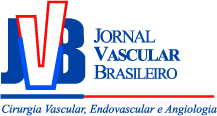Eficiência do laser diodo 980 nm em comparação à da glicose a 75% na oclusão de veias da orelha de coelhos
The efficiency of the diode laser 980 nm compared to glucose 75% in occlusion of the veins in rabbit ears
Paulo Roberto da Silva Lima; Marcelo Araújo; Guilherme Benjamin Brandão Pitta; Andressa Feitosa Bezerra de Oliveira; Guilherme Costa Guedes Pereira; José Carlos Costa Baptista-Silva
Resumo
Palavras-chave
Abstract
Keywords
Referências
Goldman MP. Escleroterapia: Tratamento das Veias Varicosas e telangiectasias dos Membros Inferiores. 1994.
Duffy D. Small vessel sclerotherapy: an overview. Advances in Dermatology. 1988:221-42.
Nicolaides NA. Patol Vasc. Consenso de Classificación de las enfermidades venosas crónicas. Patol Vasc.. 1994;1:75-85.
Prepared by an Hoc Committee at the American Venous Fórum 6th Annual Meeting in February 1994.. Classification and grading of chronic venus disease in the lower limbs: A consensus statement. Phlebology. 1995;10:42-5.
Eklöf B, Rutherford RB, Bergan JJ. Revision of the CEAP classification for chronic venous disorders: Consensus statement. J Vasc Surg.. 2004;40:1248-52.
Maffei FH, Magaldi C, Pinho SZ. Varicose veins and chronic venous insufficiency in Brazil: prevalence among 1755 inhabitants of a country town. Int J Epidemiol.. 1986;15:210-7.
Cabral ALS. Insuficiência venosa crônica de membros inferiores: prevalência, sintomas e marcadores preditivos [tese]. 2000.
Brito CJ, Duque A, Merlo I, Murilo R, Filho VLF. Escleroterapia de Veias e substâncias Esclerosantes.. Cirurgia Vascular. 2002:1067.
Bougeois A, Quillard J, Constantin JM. 66% glucose, a safe sclerosant. Experimental Study. J Mal Vasc.. 1984;9:97-9.
Weiss M, Weiss R. Sclerotherapeutic agents available in the United States and elsewere. Ambulatory Treatment of Venous Disease. 1996:123.
Imhoff E, Stemmer R. Classification and mechanism of action of sclerosing agents. Phlebologie.. 1969;22:145-8.
Tazelaar R, Neumann H. Macrosclerotherapy and compress. Ambulatory Treatment of Venous Disease. 1996:105-12.
Vin F, Schadeck M. Macroesclerotherapy and duplex techonology. Ambulatory Treatment of Venous Disease. 1996:154.
Brito CJ, Duque A, Merlo I, Murilo R, Filho VLF. O laser e a luz pulsada não coerente no tratemento das lesões vasculares benignas. Cirurgia Vascular. 2002:1455.
Goldman MP, Kaplan RP, Oki LN, Cavender PA, Strick RA, Bennett RG. Sclerosing agents in the treatment of telangiectasia: Comparison of the clinical and histologic effects of intravascular polidocanol, sodium tetradecyl sulfate, and hypertonic saline in the dorsal rabbit ear vein model. Arch Dermatol.. 1987;123:1196-201.
Miyake H, Kauffman P, Behmer AO, Wolosker M, Leão LEP. Mecanismo das necroses cutâneas provocadas por injeções esclerosantes no tratamento de microvarizes e telangiectasias: estudo experimental. Rev Ass Med Bras... 1976;22:115-20.
Goldman MP, Martin DE, Fitzpatrick RE, Ruiz-Esparza J. Pulsed dye laser treatment of telangiectases with and without subtherapeutic sclerotherapy. Clinical and histologic examination in the rabbit ear vein model. J Am Acad Dermatol.. 1990;23(1):23-30.
Santiago S, Taha MO, Fagundes DJ. Esclerose de pequenos vasos venosos com corrente elétrica galvânica ponteada, em orelhas de coelhos. Acta Cir Bras.. 2001;16:238-42.
Araújo M, Baptista-Silva JCC, Gomes PO, Juliano Y. Efeitos do ultra-som de baixa intensidade na veia auricular de coelhos. Acta Cir Bras.. 2003;18:25-31.
Vural AH, Kocogullari C, Ozyazicioğlu N. Histological results of sclerotherapy, phototherapy, and pulsed 980-nm laser irradiation of the dorsal rabbit ear vein. Photomed Laser Surg.. 2008;26:467-71.
Vieira S. Metodologia científica para a área de saúde. 1984.
Perzborn E, Strassburger J, Wilmen A. In vitro and in vivo studies of the novel antithrombotic agent BAY 59-7939 - an oral, direct Factor Xa inhibitor. J Thromb Haemost. 2005;3:514-21.
Descritores em Ciências da Saúde. 2007.
Gardner M, Altman D. Statistic with confidence: confidence intervals and statistical guidelines. 1989.
Passeron T, Olivier V, Duteil L, Desruelles F, Fontas E, Ortonne JP. The new 940-nanometer diode laser: an effective treatment for leg venulectasia. J Am Acad Dermatol.. 2003;48:768-74.
Davies MG. Hiperplasia da íntima: Resposta básica à lesão e reconstrução do enxerto arterial e venoso. Cirurgia Vascular. 2007:149-72.
Stary HC, Blankenhorn DH, Chandler AB. A definition of the intima of human arteries and of its atherosclerosis-prone regions. A report from the Committee on Vascular Lesions of the Council on Arteriosclerosis, American Heart Association. Arterioscler Thromb.. 1992;12:120-34.
Stary HC, Chandler AB, Dinsmore RE. A definition of advanced types of atherosclerotic lesions and a histological classification of atherosclerosis: A report from the Committee on Vascular Lesions of the Council on Arteriosclerosis, American Heart Association. Circulation.. 1995;92:1355-74.
Correia M, Oliveira A. Complicações em escleroterapia. Angiologia e cirurgia vascular: guia ilustrado. 2003:1-9.
Goldman MP, Kaplan RP, Duffy DM. Postsclerotherapy hyperpigmentation: a histologic evaluation. J Dermatol Surg Oncol.. 1987;13:547-50.

